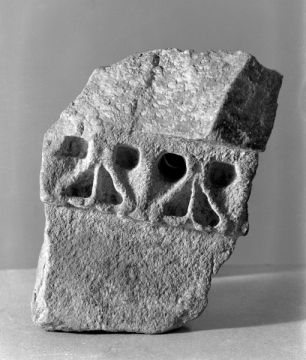Explore Collections


You are here:
CollectionsOnline
/
Fragment of the frame of a coffer from the soffit of a Roman cornice
Browse
Fragment of the frame of a coffer from the soffit of a Roman cornice
Early Empire, probably prior to the extensive Roman rebuilding programme under Augustus (end of 1st century BC)
Pentelic marble
Height: 14cm
Width: 11cm
Thickness: 6cm
Width: 11cm
Thickness: 6cm
Museum number: M595
On display: Museum South Passage
All spaces are in No. 13 Lincoln's Inn Fields unless identified as in No. 12, Soane's first house.
For tours https://www.soane.org/your-visit
Curatorial note
The workmanship indicates that this fragment is certainly an Asiatic-type moulding, probably late Hellenistic in terms of its development. There are good parallels for the general type, but in this case the quality of work is poor.
This fragment has in fact been identified by Donald Strong1 as belonging to the coffer framing of the cornice soffit of the round temple beside the Tiber in Rome (this temple is traditionally referred to as the 'Temple of Vesta' - a guess by Renaissance antiquarians - but was originally dedicated to Hercules Victor). This Roman landmark, especially well known from the paintings of I. P. Panini and innumerable drawings, was converted at an early date into the church of San Stefano Rotondo (not to be confused with the more famous San Stefano al Celio). In the 16th century it was renamed San Stefano delle Carrozze and in the 17th century was rededicated to Santa Maria del Sole (in the Piazza Bocca della Verità)2. The entablature is now completely missing and the curious conical roof which has so long characterised the church is a Renaissance or earlier restoration3. The present marble covering and the whole superstructure have been shown to date from the early Empire4, and we can unquestionably date this fragment to the same reconstruction, probably prior to the extensive rebuilding programme under the Emperor Augustus.
In addition to this Soane fragment there are several somewhat larger fragments including coffering still visible in the area beside the building on the Tiber side, and Strong has identified a large fragment with two coffers in the Cortile delle Corazze of the Vatican5.
Interestingly the original vaulted roof of the temple (missing today) was partly constructed with clay tubes, very similar to those Soane 'invented' for use in his vaulting at the Bank of England. This is a very recent discovery by Storz/Brandenburg (Sebastian Storz, Tonröhren im Antiken Gewölbebau, Mainz 1994, p. 86, note 86. It it probably unlikely that Soane knew that but he certainly must have visited the site.
1 BSR (Papers of the British School at Rome), 28, 1960, pp. 7ff.(?)
2 S.B. Platner and T. Ashby, A Topographical Dictionary of Ancient Rome, Boston, MA, 1911, p.330f. See also Margret Steinby's Roman topographical dictionary.
3 A drawing appears in Uffizi Sketchbooks, V, pl. CDXXXV, 794f., Gio. Antonio Dosio. Jahrbuch des Deutschen Archäologischen Instituts, XXXVI, 1921, pp. 66 ff.; Mitteilungen des deutschen archäologischen Instituts, Athenische Abteilung, XXXIX, 1914, p.25 f.
5 A number of drawings exist and a Valadier reconstruction appears in Visconto, Raccolta, 1810; see also L. Canina, Gli Edifici di Roma antica, cognitti per alcune importanti reliquie descritti e dimostrati nell''intera loro architettura, 4 vols, Rome, 1848-51, II, pl. LXIV.
This fragment has in fact been identified by Donald Strong1 as belonging to the coffer framing of the cornice soffit of the round temple beside the Tiber in Rome (this temple is traditionally referred to as the 'Temple of Vesta' - a guess by Renaissance antiquarians - but was originally dedicated to Hercules Victor). This Roman landmark, especially well known from the paintings of I. P. Panini and innumerable drawings, was converted at an early date into the church of San Stefano Rotondo (not to be confused with the more famous San Stefano al Celio). In the 16th century it was renamed San Stefano delle Carrozze and in the 17th century was rededicated to Santa Maria del Sole (in the Piazza Bocca della Verità)2. The entablature is now completely missing and the curious conical roof which has so long characterised the church is a Renaissance or earlier restoration3. The present marble covering and the whole superstructure have been shown to date from the early Empire4, and we can unquestionably date this fragment to the same reconstruction, probably prior to the extensive rebuilding programme under the Emperor Augustus.
In addition to this Soane fragment there are several somewhat larger fragments including coffering still visible in the area beside the building on the Tiber side, and Strong has identified a large fragment with two coffers in the Cortile delle Corazze of the Vatican5.
Interestingly the original vaulted roof of the temple (missing today) was partly constructed with clay tubes, very similar to those Soane 'invented' for use in his vaulting at the Bank of England. This is a very recent discovery by Storz/Brandenburg (Sebastian Storz, Tonröhren im Antiken Gewölbebau, Mainz 1994, p. 86, note 86. It it probably unlikely that Soane knew that but he certainly must have visited the site.
1 BSR (Papers of the British School at Rome), 28, 1960, pp. 7ff.(?)
2 S.B. Platner and T. Ashby, A Topographical Dictionary of Ancient Rome, Boston, MA, 1911, p.330f. See also Margret Steinby's Roman topographical dictionary.
3 A drawing appears in Uffizi Sketchbooks, V, pl. CDXXXV, 794f., Gio. Antonio Dosio. Jahrbuch des Deutschen Archäologischen Instituts, XXXVI, 1921, pp. 66 ff.; Mitteilungen des deutschen archäologischen Instituts, Athenische Abteilung, XXXIX, 1914, p.25 f.
5 A number of drawings exist and a Valadier reconstruction appears in Visconto, Raccolta, 1810; see also L. Canina, Gli Edifici di Roma antica, cognitti per alcune importanti reliquie descritti e dimostrati nell''intera loro architettura, 4 vols, Rome, 1848-51, II, pl. LXIV.
Unrecorded.
Soane collections online is being continually updated. If you wish to find out more or if you have any further information about this object please contact us: worksofart@soane.org.uk


